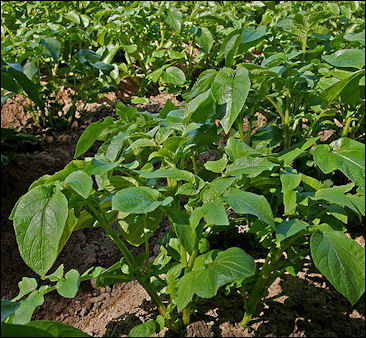POTATOES
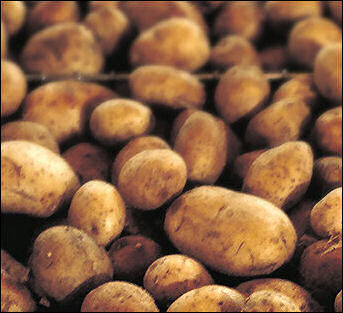
Even though they are 80 percent water potatoes are one of the most nutritiously complete foods. They are packed with protein, carbohydrates and numerous vitamins and minerals — including potassium and vitamin C and important trace minerals — and are 99.9 percent fat-free The are so nutritious it is possible to live solely on potatoes and one protein-rich food such as milk. Charles Crissman of the International Potato Center in Lima told the Times of London, “On mashed potatos alone, you would be doing pretty good.”
Potatoes, cassava, sweet potatoes and yams are tubers. Contrary to what many people think tubers are not roots. They are underground stems that serve as food storage units for the green foliage above the ground. Roots absorb nutrients, tubers store them.
Potatoes are a tuber not a root. They belong to the “Solanum” , genus of plants, which also includes the tomato, pepper, eggplant, petunia, tobacco plants and deadly nightshade and more than other 2,000 species, of which about 160 are tubers. [Source: Robert Rhoades, National Geographic, May 1992 ╺; Meredith Sayles Hughes, Smithsonian]
Potatoes are regarded as the world’s forth most important food after corn, wheat and rice. The United Nations declared 2008 to be the International Year of the Potato. Potatoes are an ideal crop. They produce a lot of food; don’t take long to grow; do well in poor soils; tolerate bad weather and don’t require much skill to raise. An acre of these tubers yields twice as much food as an acre of grain and matures in 90 to 120 days. One nutritionist told the Los Angeles Times that potatoes are “a great way of turning the ground into a calorie machine.”
Books: “Potato, A History of the Propitious Esculent” by John Read (Yale University, 2009); “The Potato, How the Humble Spud Rescued the Western World” by Larry Zuckerman (Faber & Faber, 1998).
Websites and Resources: GLKS Potato Database glks.ipk-gatersleben.de ; The International Potato Center in Lima cipotato.org ; Wikipedia article Wikipedia ; World Potato Congress potatocongress.org ; Potato Research potatoes.wsu.edu ; Year of the Potato 2008 potato2008.org ; Healthy Potato healthypotato.com ; Idaho Potato idahopotato.com ; Potato Museum potatomuseum.com ;
See Separate Article ROOTS AND TUBERS: SWEET POTATOES, CASSAVA AND YAMS factsanddetails.com
Potatoes yield four times more calories per acre than grains. They also do well where other crops do not. They have been grown in the scorching deserts of Australia; the rain forests of Africa; the slopes of 14,000-foot-high Andean peaks; and the depths of the Turban Depression of western China, the second lowest place on earth. Potatoes grow best in cool climates and are an idea crop for mountainous areas and cold places.
World’s Top Potato Producing Countries
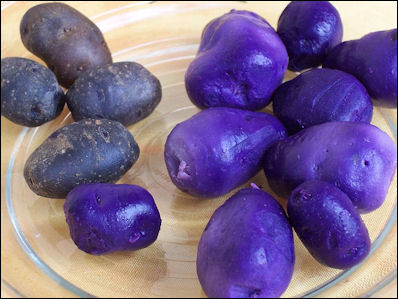
Vitelotte potatoesSome 300 million tons of potatoes worth about $140 billion dollars are raised in about 150 countries every year. Only corn is found in more places. If all the world's potatoes were placed together they would cover a four-lane highway circling the world six times.
World’s Top Producers of Potatoes (2020): 1) China: 78183874 tonnes; 2) India: 51300000 tonnes; 3) Ukraine: 20837990 tonnes; 4) Russia: 19607361 tonnes; 5) United States: 18789970 tonnes; 6) Germany: 11715100 tonnes; 7) Bangladesh: 9606000 tonnes; 8) France: 8691900 tonnes; 9) Poland: 7848600 tonnes; 10) Netherlands: 7020060 tonnes; 11) United Kingdom: 5520000 tonnes; 12) Peru: 5467041 tonnes; 13) Canada: 5295484 tonnes; 14) Belarus: 5231168 tonnes; 15) Egypt: 5215905 tonnes; 16) Turkey: 5200000 tonnes; 17) Algeria: 4659482 tonnes; 18) Pakistan: 4552656 tonnes; 19) Iran: 4474886 tonnes; 20) Kazakhstan: 4006780 tonnes [Source: FAOSTAT, Food and Agriculture Organization (U.N.), fao.org. A tonne (or metric ton) is a metric unit of mass equivalent to 1,000 kilograms (kgs) or 2,204.6 pounds (lbs). A ton is an imperial unit of mass equivalent to 1,016.047 kg or 2,240 lbs.]
World’s Top Producers (in terms of value) of Potatoes (2019): 1) China: Int.$22979444,000 ; 2) India: Int.$12561005,000 ; 3) Russia: Int.$5524658,000 ; 4) Ukraine: Int.$5072751,000 ; 5) United States: Int.$4800654,000 ; 6) Germany: Int.$2653403,000 ; 7) Bangladesh: Int.$2416368,000 ; 8) France: Int.$2142406,000 ; 9) Netherlands: Int.$1742181,000 ; 10) Poland: Int.$1622149,000 ; 11) Belarus: Int.$1527966,000 ; 12) Canada: Int.$1353890,000 ; 13) Peru: Int.$1334200,000 ; 14) United Kingdom: Int.$1314413,000 ; 15) Egypt: Int.$1270960,000 ; 16) Algeria: Int.$1256413,000 ; 17) Turkey: Int.$1246296,000 ; 18) Pakistan: Int.$1218638,000 ; 19) Belgium: Int.$1007989,000 ; [An international dollar (Int.$) buys a comparable amount of goods in the cited country that a U.S. dollar would buy in the United States.]
Top Potato-Producing Countries in 2008: (Production, $1000; Production, metric tons, FAO): 1) China, 8486396 , 68759652; 2) India, 4602900 , 34658000; 3) Russian Federation, 2828622 , 28874230; 4) United States of America, 2560777 , 18826578; 5) Germany, 1537820 , 11369000; 6) Ukraine, 1007259 , 19545400; 7) Poland, 921807 , 10462100; 8) France, 921533 , 6808210; 9) Netherlands, 915657 , 6922700; 10) Bangladesh, 905982 , 6648000; 11) United Kingdom, 819387 , 5999000; 12) Iran (Islamic Republic of), 660373 , 4706722; 13) Canada, 656272 , 4460; 14) Turkey, 565770 , 4196522; 15) Brazil, 495502 , 3676938; 16) Egypt, 488390 , 3567050; 17) Peru, 432147 , 3578900; 18) Belarus, 389985 , 8748630; 19) Japan, 374782 , 2743000; 20) Pakistan, 349 , 2539000;
In the 1990s the main potato producers were Russia, China and Poland. Top 5 potato growers in 1991 (million tones per year): 1) former USSR (60); 2) China (32.5); 3) Poland (32); 4) USA (18.9); 5) India (15.6).
Early History of Potatoes
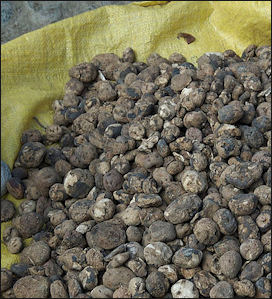
Chuno potatoes from the Andes Potatoes are one of the world’s oldest foods. The have been grown in their place of origin, South America, as long as the first cultivated in the Fertile Crescent. The first wild potatoes were harvested as high as 14,000 feet in Andes perhaps as long as 13,000 years.
There are several varieties of wild potatoes but most potatoes eaten around the world today descended from one species, Solanum tuberosum, which was domesticated in the South American Andes more than 7,000 years ago and has been bred into thousands of different types since then. Of the seven cultivated species of potato six are still grown only in the upper elevations of the Peruvian Andes. The seventh, S. tuberosum, grows in the Andes too, where it is known as “unproved potato” but also grows well at lower elevations and is grown all over the world as dozens of different vanities of potatoes that we know and love.
The wild potato-like plants come in wide variety and range over an area in the Andes that extends from Venezuela to northern Argentina. There is so much diversity among these plants that scientists have long thought that early potatoes were cultivated at different times in different places, perhaps from different species. A study in the mid 2000s by scientist from the University of Wisconsin of 365 specimens of potato as well as primitive species and wild plants seems to indicate that all modern potatoes come from a single species, the wild plant “Solanum bukasovi” , native to southern Peru.
Evidence of potato domestication has been found at a 12,500-year-old archeological site in Chile. Potatoes are thought to have been first widely cultivated around 7000 year ago. Before 6000 B.C. nomadic Indians are believed to have collected wild potatoes on the central Andean plateau, 12,000 feet high. Over the millennia they developed potato agriculture.
It has been suggested that potatoes changed history. Featured in the golden garden of the Incas in Cuzco and in the court of Louis XVI, they contributed to population surges in Europe in the 18th century, a surge in European imperialism in the 19th century and even China’s rise in the 21st century. It has been suggested that potatoes are the perfect food to take on a mission to Mars.
10,900-Year-Old Mashed Potatos Found in Utah
Potato starch residues found on 10,900-year-old stone grinding tools from the North Creek Shelter site in Utah may be the oldest known evidence of potato domestication and consumption in North America. According to Archaeology magazine: The granules belong to a species known as the Four Corners potato, which is native to the southwestern United States, although rare today. In Utah’s Escalante Valley, they are found exclusively around archaeological sites, suggesting these tubers were an important part of prehistoric human diets in the area. [Source: Jason Urbanus, Archaeology magazine, November-December 2017]

16th century drawing of a potato plant,
the oldest known The “well-preserved starch granules” were discovered in cracks in rocks used to grind up the potatoes Ian Johnston wrote in The Independent: The potato starch was embedded into stone tools found in Escalante, Utah, an area once known to early European settlers as “Potato Valley”.
The ‘Four Corners’ potatoes, Solanum jamesii, were eaten by several Native American tribes, including the Apache, Navajo and Hopi. The Four Corners potato, which may be the first example of a domesticated plant in the American West, could be used to make the current potato crop more resilient to drought and disease, it is believed.[Source: Ian Johnston, The Independent, July 3, 2017]
Professor Lisbeth Louderback, an archaeologist at the Natural History Museum of Utah and a senior author of a paper published in the journal Proceedings of the National Academy of Sciences, said: “This potato could be just as important as those we eat today, not only in terms of a food plant from the past, but as a potential food source for the future. “The potato has become a forgotten part of Escalante’s history. Our work is to help rediscover this heritage.” S. jamesii is also highly nutritious with twice the amount of protein, zinc and manganese and three times the calcium and iron content as S. tuberosum.
Grown in ideal conditions in a greenhouse, a single “mother” tuber can produce 125 progeny tubers in six months. Early European visitors to the Escalante area remarked on the potatoes. Captain James Andrus wrote in August 1866: “We have found wild potatoes growing from which the valley takes its name.” And a soldier, John Adams, wrote in the same year: “We gathered some wild potatoes which we cooked and ate … they were somewhat like the cultivated potato, but smaller.”
Potatoes in Europe
Spanish conquistadors brought potatoes back to Europe from their missions in Peru. Sir Walter Raleigh presented a potato to Queen Elizabeth I. In 1570s the tuber was given to patients in Seville hospital and later prescribed by some herbalists as an aphrodisiac. Shakespeare also described them as such yet Europeans tended to suspicious of the food however because it was related to the poisonous nightshade plant and was not mentioned in the Bible. Some blamed it for outbreaks of leprosy and tuberculosis. The British considered potatoes for cattle feed but only after a seven year study.
For 200 years potatoes remained little more than a botanical curiosities in Europe, but in the late 18th century finally they caught on with the masses, providing food surpluses for population expansions necessary to fuel Europe's industrial growth. Some have argued that potatoes were as important to the Industrial Revolution as steam power and looms. "For the first time," wrote Hughes, "the poor had an easily grown, easily processed, highly nutritious food that could be raised in small, family plots. One acre planted in potatoes could feed four times a many people as an acre planted in rye or wheat.”
Potatoes did not become a staple food in Europe until the 17th and 18th centuries and were only embraced because other food sources — namely grains, which can be easily burned — were ravaged by war while potatoes were hidden safely in the ground and could easily be harvested and stored when the fighting stopped.
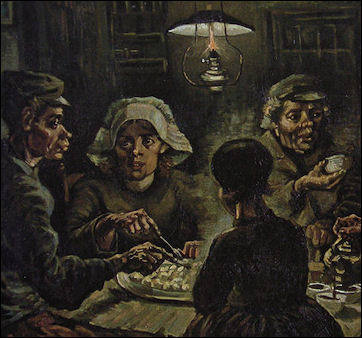
Potatoes Eaters by van Gogh Potatoes contributed significantly to population growth throughout Europe between 1750 and 1850.. Low in fat, high in vitamins, the potato helped more children survived to adulthood and adults produce lots of children. Since the extra people were not all needed on the family farms, many of them went to the cities to work.
In the Great Potato War of 1778 the Austrians fought against the Prussians in Bohemia. In this war of attrition both side fortified their positions, occasionally fired some shots, and sat back and ate potatoes, the first side that ran was the loser, and that turned out to be Prussia.
The British Empire Potato Collection Expedition of 1938 to South America collected more than 1,100 potato species, “many of which had never been described before.” The English turned to potatoes during World War II as means of feeding their population when German submarines blockaded British ports and kept other food stuffs from coming in. The Germans in turn were using potato-derived-alcohol to fuel some of their planes.
The blight hit Poland in 1980 and wiped over half of the potato crop. In Poland potatoes are used as livestock feed and over half of the country's animals had to be slaughtered.
Uses of Potatoes
Potato starch is a low fat food additives found in a wide range of processed meals, soups, bakery goods, and deserts, including ice cream. In China their chip making machines sometime malfunction filling their factories raining potato chips.
Potato starch is used in the production of paper, adhesive and textile goods. The potato yields up a superabsorbant biodegradable material for use in disposable diapers. It provides starch products to keep oil well drilling bits smooth and to hold together the ingredients in lipsticks and cosmetic creams." It is also used in biodegradable packing peanuts and time -released capsules. Potatoes protein may soon contribute components to artificial blood serum for human use.
The only part of the potato that isn't useful is the peel. Despite what mothers around the world have said the peel doesn't have any more nutrients than the rest of the potato, but it does have a lot of a mild poison called solanine. Doctors in India have successfully used potato skins as a dressing on burn victims.
Potatoes in the Developing World
potato plants Potatoes are grown in meager hillside village plots and on huge industrial farms and packaged in industria processing centers. In most places potatoes have been introduced they have raised the population but have not done much to lift people out of poverty.
The United Nations is trying to convince some places in the developing world to switch from rice to potatoes as their staple food as potatoes need less water and space, grow faster, produce more food, have higher nutritional value and are easier to grow. Potato consumption has risen substantially during the past four decades in Asia, Africa and Latin America, with output increasing from 30 million tons in the 1960s to almost 120 million tons by the 1990s. Potatoes have traditionally been eaten mostly in the North America, Europe and the former Soviet Union.
Today China is the largest potato producer and almost a third of all potatoes are harvested in China and India. One of the biggest forces behind rising potato prices and increased production is demand for fast food in China and other developing countries.
There are GM potatoes varieties but thus far they have not been embraced by the market.
World’s Top Potato Exporting Countries
World’s Top Exporters of Potatoes (2020): 1) France: 2336371 tonnes; 2) Netherlands: 2064784 tonnes; 3) Germany: 1976561 tonnes; 4) Belgium: 1083120 tonnes; 5) Egypt: 636437 tonnes; 6) Canada: 529510 tonnes; 7) United States: 506172 tonnes; 8) China: 441849 tonnes; 9) Russia: 424001 tonnes; 10) Kazakhstan: 359622 tonnes; 11) India: 296409 tonnes; 12) Spain: 291982 tonnes; 13) Belarus: 291883 tonnes; 14) United Kingdom: 283971 tonnes; 15) Pakistan: 274477 tonnes; 16) South Africa: 173046 tonnes; 17) Denmark: 151730 tonnes; 18) Israel: 147106 tonnes; 19) Iran: 132531 tonnes; 20) Turkey: 128395 tonnes [Source: FAOSTAT, Food and Agriculture Organization (U.N.), fao.org]
World’s Top Exporters (in value terms) of Potatoes (2020): 1) Netherlands: US$830197,000; 2) France: US$681452,000; 3) Germany: US$376909,000; 4) Canada: US$296663,000; 5) China: US$289732,000; 6) United States: US$244468,000; 7) Belgium: US$223452,000; 8) Egypt: US$221948,000; 9) United Kingdom: US$138732,000; 10) Spain: US$117547,000; 11) India: US$71637,000; 12) Pakistan: US$69846,000; 13) Israel: US$66171,000; 14) Denmark: US$54353,000; 15) Russia: US$50469,000; 16) Italy: US$48678,000; 17) Belarus: US$45220,000; 18) South Africa: US$42896,000; 19) Cyprus: US$41834,000; 20) Azerbaijan: US$33786,000
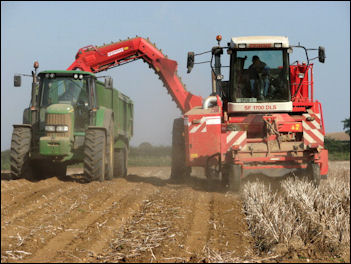
Potato harvest World’s Top Exporters of Frozen Potatoes (2020): 1) Belgium: 2591518 tonnes; 2) Netherlands: 1613784 tonnes; 3) Canada: 1025152 tonnes; 4) United States: 909415 tonnes; 5) Germany: 330885 tonnes; 6) France: 294020 tonnes; 7) Argentina: 195795 tonnes; 8) Poland: 168823 tonnes; 9) Pakistan: 66517 tonnes; 10) New Zealand: 61778 tonnes; 11) United Kingdom: 61530 tonnes; 12) India: 60353 tonnes; 13) Austria: 52238 tonnes; 14) China: 51248 tonnes; 15) Egypt: 50719 tonnes; 16) Turkey: 44787 tonnes; 17) Spain: 34476 tonnes; 18) Greece: 33806 tonnes; 19) South Africa: 15448 tonnes; 20) Denmark: 14892 tonnes
World’s Top Exporters (in value terms) of Frozen Potatoes (2020): 1) Belgium: US$2013349,000; 2) Netherlands: US$1489792,000; 3) Canada: US$1048295,000; 4) United States: US$1045448,000; 5) France: US$316723,000; 6) Germany: US$287654,000; 7) Argentina: US$165899,000; 8) Poland: US$146121,000; 9) United Kingdom: US$69871,000; 10) China: US$58581,000; 11) New Zealand: US$52758,000; 12) Egypt: US$47953,000; 13) Austria: US$46279,000; 14) India: US$43529,000; 15) Turkey: US$32746,000; 16) Spain: US$24805,000; 17) Denmark: US$18591,000; 18) South Africa: US$16220,000; 19) Pakistan: US$15348,000; 20) Australia: US$12977,000
World’s Top Potato Importing Countries
World’s Top Importers of Potatoes (2020): 1) Belgium: 3024137 tonnes; 2) Netherlands: 1651026 tonnes; 3) Spain: 922149 tonnes; 4) Germany: 681348 tonnes; 5) Italy: 617657 tonnes; 6) United States: 501489 tonnes; 7) Uzbekistan: 450994 tonnes; 8) Iraq: 415000 tonnes; 9) Portugal: 387990 tonnes; 10) France: 327690 tonnes; 11) Russia: 316225 tonnes; 12) Ukraine: 301668 tonnes; 13) United Arab Emirates: 254580 tonnes; 14) Malaysia: 236016 tonnes; 15) United Kingdom: 228332 tonnes; 16) Poland: 208315 tonnes; 17) Czechia: 198592 tonnes; 18) Canada: 188776 tonnes; 19) Nepal: 186772 tonnes; 20) Azerbaijan: 182654 tonnes [Source: FAOSTAT, Food and Agriculture Organization (U.N.), fao.org]
World’s Top Importers (in value terms) of Potatoes (2020): 1) Belgium: US$610148,000; 2) Netherlands: US$344404,000; 3) Spain: US$316563,000; 4) United States: US$285759,000; 5) Germany: US$254494,000; 6) Italy: US$200936,000; 7) United Kingdom: US$138163,000; 8) Iraq: US$134000,000; 9) Russia: US$125654,000; 10) France: US$101113,000; 11) Portugal: US$99478,000; 12) Canada: US$89383,000; 13) Malaysia: US$85863,000; 14) Egypt: US$76813,000; 15) Greece: US$73251,000; 16) United Arab Emirates: US$69882,000; 17) Poland: US$65893,000; 18) Ukraine: US$61922,000; 19) Mexico: US$60291,000; 20) Czechia: US$56214,000
World’s Top Potatoes Flour Exporting Countries
World’s Top Exporters of Potato Flour (2020): 1) Germany: 154341 tonnes; 2) Netherlands: 133338 tonnes; 3) Belgium: 91611 tonnes; 4) United States: 82835 tonnes; 5) Denmark: 24801 tonnes; 6) Poland: 19890 tonnes; 7) Honduras: 10305 tonnes; 8) Canada: 9649 tonnes; 9) Russia: 8580 tonnes; 10) France: 8554 tonnes; 11) India: 5568 tonnes; 12) Saudi Arabia: 4936 tonnes; 13) Italy: 4841 tonnes; 14) Lebanon: 4529 tonnes; 15) United Kingdom: 2903 tonnes; 16) Spain: 2408 tonnes; 17) Belarus: 2306 tonnes; 18) Guyana: 2048 tonnes; 19) South Africa: 1270 tonnes; 20) Myanmar: 1058 tonnes; 20) Iran: 1058 tonnes [Source: FAOSTAT, Food and Agriculture Organization (U.N.), fao.org]
World’s Top Exporters (in value terms) of Potato Flour (2020): 1) Germany: US$222116,000; 2) Netherlands: US$165610,000; 3) United States: US$116655,000; 4) Belgium: US$109519,000; 5) Denmark: US$31972,000; 6) Poland: US$26064,000; 7) France: US$15489,000; 8) Canada: US$13341,000; 9) Italy: US$13318,000; 10) Russia: US$9324,000; 11) Lebanon: US$7633,000; 12) India: US$5448,000; 13) Spain: US$5227,000; 14) United Kingdom: US$4400,000; 15) Belarus: US$2404,000; 16) United Arab Emirates: US$2365,000; 17) Ireland: US$2118,000; 18) Saudi Arabia: US$1568,000; 19) Myanmar: US$1548,000; 20) Slovenia: US$1526,000
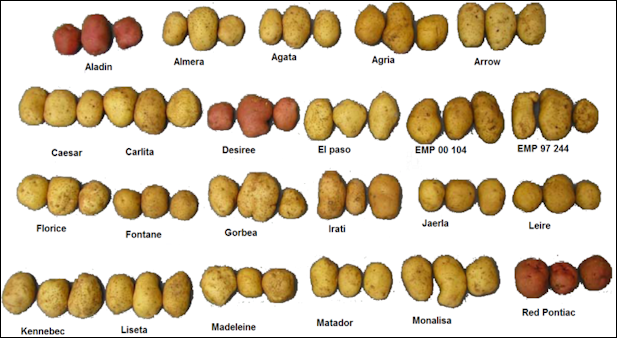
Varieties of potatoes
World’s Top Exporters of Potato Offals (2020): 1) Eswatini: 30 tonnes. World’s Top Exporters (in value terms) of Potato Offals (2020): 1) Eswatini: US$4,000 World’s Top Importers of Potato Offals (2020): 1) Myanmar: 122559 tonnes; 2) Eswatini: 36 tonnes. World’s Top Importers (in value terms) of Potato Offals (2020): 1) Myanmar: 46805,000; 2) Eswatini: 6,000
Image Sources: Wikimedia Commons
Text Sources: National Geographic, New York Times, Washington Post, Los Angeles Times, Smithsonian magazine, Natural History magazine, Discover magazine, Times of London, The New Yorker, Time, Newsweek, Reuters, AP, AFP, Lonely Planet Guides, Compton’s Encyclopedia and various books and other publications.
Last updated March 2022

